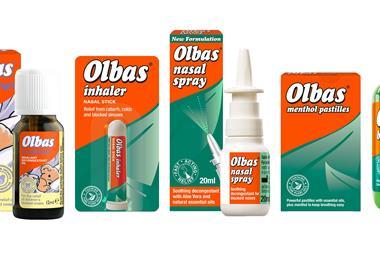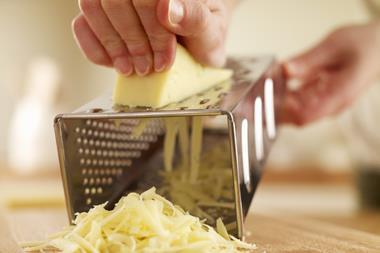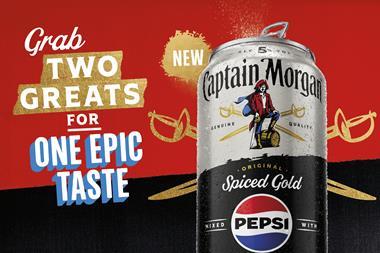Bread remains a firm favourite in the UK and even fads like the Atkins diet couldn't dent a sector in which sales reach more than £1.3bn a year. It's a category that no c-store is complete without and while the c-stores aren't performing quite as well as the overall market, which is up 8% year-on-year in value terms, they are still enjoying 4.1% growth (Source AC Nielsen/Warburtons Bakery Review 2005).
The positive outlook comes despite total bread units remaining reasonably static at -0.2% year-on-year - and it's all down to shoppers' keenness to trade up to premium products.
The brown, grains and seeded share of the total wrapped bread category has grown considerably to 26.1%. Organic bread sales are up 6.1% and even white bread has felt the benefits of the healthy eating movement. The top three manufacturers have all introduced white everyday loaves with the added benefits of wholemeal. Warburtons All in One, Hovis Best of Both and Kingsmill Whole & White account for 11.5% of total white everyday loaves. In contrast, economy bread sales continue to slide and now make up just 2% of bread value sales.
"Bread is a huge category for convenience retailers," says Sarah Miskell, category controller at Warburtons. "Buying bread is often the main reason shoppers visit
c-stores. Customers expect to find fresh bread and if their local store runs out, it is a big turn-off. It's important retailers maximise their bread sales to boost sales across the rest of the store. One way this can be achieved is by stocking the best-sellers in each sub-category."
Miskell recommends convenience retailers with limited space concentrate on stocking breadth rather than depth of range. "It's not worth stocking five different types of crumpet, for example," she says. "The most important factor is availability. Retailers must make sure a bakery product they are selling one day is also available
the next."
With impulse purchases vital to the category, Miskell also advises placing the bakery section near the front of the store. She believes there are good opportunities for cross-purchasing, too, and recommends where possible placing bread and morning goods close to the milk chillers to help boost profits.
She adds: "We bake and deliver fresh seven days a week and have about 900 vehicles on the road. Our salesforce pay regular visits to stores, so they get a good idea of each retailer's sales pattern. Every store will sell different amounts - the important thing is that retailers are aware of how much stock is leaving their shelves."
Marketing director at Allied Bakeries, Jon Wilson, agrees that bread and morning goods should be central to any c-store. "Bread is one of the most important lines within c-stores," he says. "It is one of the most typical top-up shops, with 53% of shoppers buying bread when they visit. Bread shoppers spend an average of £6.97 per trip and average about four trips per week, so the category should be given special attention in order to maximise sales."
Wilson believes it's vital retailers respond to the changing diet of the nation and cites the success of Allied's Burgen loaf, which was given a packaging makeover at the beginning of 2006, as one example of the trend. He says: "Certain health trends have had a significant and positive impact on category growth. The growth in the interest in the glycemic index (GI) of certain foods has fuelled sales of bread that have low GI values. Burgen's low GI line, Soya and Linseed, is worth £7.6m and is doing exceptionally well with growth of 67% year on year.
"Consumers are now also keen on products with specific health benefits. Our Kingsmill Head Start with Omega 3 is a response to this trend. The product is the first Omega 3 loaf from a major bread brand in 2006 and a convenient way to boost Omega 3 levels, particularly for children."
RHM Bakeries points out that added health benefits is one of three trends to watch out for. Says Hovis brand manager Ifan Jenkins: "The health side of the market is set to continue to grow; shoppers will look to buy more premium products; and the number of small households buying smaller loaves will also continue to rise."
The company has announced a £20m investment in premium products, packaging and advertising of its Hovis brand. New products include Hovis Supreme White, Hovis Farmhouse Best of Both and, following the relaunch of Hovis Granary in February, Hovis Oatmeal Granary.
The company is also launching two 400g granary loaves, White Granary and Country Granary, to meet the growing demand from smaller households.
Adds Jenkins: "We see ourselves at the forefront of innovation. While white bread still makes up more than half of the market, shoppers are buying a wider range of products. Initially, we couldn't make enough of our crustless and Best of Both ranges. C-stores should provide a broad selection across the key
sub-sectors of white, brown, seeded and half and half."
The wrapped rolls sector is dominated by own label, which has a 51.9% share. Warburtons has six of the top 10 branded SKUs and has seen a 33.4% increase in the value of its 12 white large sliced sandwich rolls. Other products selling well include Kingsmill six soft white rolls, which enjoyed 25.6% value growth in 2005 compared with the previous year.
Manufacturers point out that although c-store retailers should stock rolls all year round, their sales can be highly seasonal.
Warburtons category controller Sarah Miskell says: "Rolls sell fantastically throughout the barbecue season. Our 12-pack of sliced white rolls, for example, flies off the shelves when there's any hot weather.
"Incremental sales can also be gained by customers who initially intended to stock up on beer or wine for a barbecue."
Hovis brand manager Ifan Jenkins echoes Miskell's view and adds: "Rolls are heavily seasonal. While customers will expect to find them in the store all year round, the summer barbecue season and back-to-school periods are times of the year when retailers should expect demand for them to rise."
How is the wrapped bread and morning goods category currently performing?
The category is performing well with both innovation from manufacturers as well as consumer demand for healthy products driving the category.
How important is the category to convenience retailers?
Bread is a convenience product and remains extremely important to convenience retailers. It's exactly the sort of product that consumers will pop out to buy when they need to, instead of going to a supermarket. It's therefore important retailers maintain a focus on bread. It has been a staple in the UK for hundreds of years and will remain so for years to come.
What impact has the focus on health had on the category?
Consumers are getting wise to faddy diets and are realising that eliminating food groups is not the way to a healthy lifestyle. The Federation has for many years taken a proactive approach to salt reduction. Salt levels in bread have been reduced by some 25% over the past 20 years and as recently as 2005 the industry implemented a further 5% reduction.
How important has innovation been to the category?
Innovation is key to the growth of the market and manufacturers have been working to deliver products that consumers want. They are meeting the requirements of the consumer, whether it be through innovative wholemeal breads, brown, white or products that help children eat healthier. It will continue to play a large role in the further development of the bread market as manufacturers continue to meet consumer demand.
What are the major trends that you can see emerging over the next year?
Further innovation from manufacturers will continue to be apparent in the next year, as will meeting the needs of consumers as they seek healthy, convenient products.
While it's important to keep an eye on developments from all the major manufacturers, it's also worth remembering that the bread and morning goods category can differ enormously by region.
Warburtons continues to dominate market share in central England, Yorkshire, Lancashire, the North East and Scotland. Although Warburtons expects to increase its share in the South, Wales and London, Kingsmill and Hovis remain the more popular brands there. Smaller brands that are performing well regionally, too, include Mothers Pride in Scotland and Braces in Wales.
Top 10 wrapped bread in value
1. Warburtons 800g white Toastie
2. Hovis 800g square cut medium
3. Warburtons 800g medium
4. Kingsmill 800g square cut medium
5. Kingsmill 800g square cut thick
6. Hovis 800g Best of Both medium
7. Warburtons 800g farmhouse
8. Warburtons 400g wholemeal
9. Hovis 800g wholemeal
10. Hovis 800g square cut thick
Top 10 wrapped branded rolls
1. Warburtons 12 white sliced sandwich
2. Kingsmill 6 soft white
3. Warburtons 3 soft sandwich
4. Warburtons 4 white sandwich
5. Warburtons 6 white sliced sandwich
6. Kingsmill whole and white
7. Warburtons 12 white large sliced sandwich
8. Hovis 4 white cobble
9. Kingsmill 4 tasty wholemeal
10 Warburtons 3 seeded
Source: AC Nielsen/Warburtons Bakery Review 2005
l Look at vertical block merchandising bread so it is merchandised to the top of units, not below morning goods
l Is bread visible to shoppers from the entrance of the store? Bread sales are higher in stores where the bread can be seen from the doorway
l Don't expect shoppers to trudge to the back of the store picking up other products along the way. Make life easy for your customers
l One of the top cross-purchases with bread is milk. Make it easy for shoppers to buy both products together
l Best-in-class retailers merchandise bread
side-on not end-on
l Do you know who your bread shoppers are and at what time of the day they normally shop?
l Organise regular, two-hour availability checks and introduce a bread availability guarantee
l Don't discount bread just before it goes off sale. It harms the overall image of the store
l Understand the role of bread in c-stores. Do you need to price promote bread, a category that is often a distress purchase?
l Could the category benefit from some of the theatre seen in other categories?
Source: HIM Convenience Tracking Programme
l Croissants remain the biggest sector in continental breakfast
l Bagels have increased their value share of the continental sector by 24.2%
l The value of brioche rose by a massive 102%,
but is growing from a small base
l Reversing 2004 trends, the total fruited sector is increasing in both volume and value sales
l Tea cakes are showing a strong resurgence
l Fruited scones are still enjoying good year-on-year growth of 8.4%.
Source: AC Nielsen/Warburtons Bakery Review 2005
The positive outlook comes despite total bread units remaining reasonably static at -0.2% year-on-year - and it's all down to shoppers' keenness to trade up to premium products.
The brown, grains and seeded share of the total wrapped bread category has grown considerably to 26.1%. Organic bread sales are up 6.1% and even white bread has felt the benefits of the healthy eating movement. The top three manufacturers have all introduced white everyday loaves with the added benefits of wholemeal. Warburtons All in One, Hovis Best of Both and Kingsmill Whole & White account for 11.5% of total white everyday loaves. In contrast, economy bread sales continue to slide and now make up just 2% of bread value sales.
"Bread is a huge category for convenience retailers," says Sarah Miskell, category controller at Warburtons. "Buying bread is often the main reason shoppers visit
c-stores. Customers expect to find fresh bread and if their local store runs out, it is a big turn-off. It's important retailers maximise their bread sales to boost sales across the rest of the store. One way this can be achieved is by stocking the best-sellers in each sub-category."
Miskell recommends convenience retailers with limited space concentrate on stocking breadth rather than depth of range. "It's not worth stocking five different types of crumpet, for example," she says. "The most important factor is availability. Retailers must make sure a bakery product they are selling one day is also available
the next."
With impulse purchases vital to the category, Miskell also advises placing the bakery section near the front of the store. She believes there are good opportunities for cross-purchasing, too, and recommends where possible placing bread and morning goods close to the milk chillers to help boost profits.
She adds: "We bake and deliver fresh seven days a week and have about 900 vehicles on the road. Our salesforce pay regular visits to stores, so they get a good idea of each retailer's sales pattern. Every store will sell different amounts - the important thing is that retailers are aware of how much stock is leaving their shelves."
Marketing director at Allied Bakeries, Jon Wilson, agrees that bread and morning goods should be central to any c-store. "Bread is one of the most important lines within c-stores," he says. "It is one of the most typical top-up shops, with 53% of shoppers buying bread when they visit. Bread shoppers spend an average of £6.97 per trip and average about four trips per week, so the category should be given special attention in order to maximise sales."
Wilson believes it's vital retailers respond to the changing diet of the nation and cites the success of Allied's Burgen loaf, which was given a packaging makeover at the beginning of 2006, as one example of the trend. He says: "Certain health trends have had a significant and positive impact on category growth. The growth in the interest in the glycemic index (GI) of certain foods has fuelled sales of bread that have low GI values. Burgen's low GI line, Soya and Linseed, is worth £7.6m and is doing exceptionally well with growth of 67% year on year.
"Consumers are now also keen on products with specific health benefits. Our Kingsmill Head Start with Omega 3 is a response to this trend. The product is the first Omega 3 loaf from a major bread brand in 2006 and a convenient way to boost Omega 3 levels, particularly for children."
RHM Bakeries points out that added health benefits is one of three trends to watch out for. Says Hovis brand manager Ifan Jenkins: "The health side of the market is set to continue to grow; shoppers will look to buy more premium products; and the number of small households buying smaller loaves will also continue to rise."
The company has announced a £20m investment in premium products, packaging and advertising of its Hovis brand. New products include Hovis Supreme White, Hovis Farmhouse Best of Both and, following the relaunch of Hovis Granary in February, Hovis Oatmeal Granary.
The company is also launching two 400g granary loaves, White Granary and Country Granary, to meet the growing demand from smaller households.
Adds Jenkins: "We see ourselves at the forefront of innovation. While white bread still makes up more than half of the market, shoppers are buying a wider range of products. Initially, we couldn't make enough of our crustless and Best of Both ranges. C-stores should provide a broad selection across the key
sub-sectors of white, brown, seeded and half and half."
Roll with it
The wrapped rolls sector is dominated by own label, which has a 51.9% share. Warburtons has six of the top 10 branded SKUs and has seen a 33.4% increase in the value of its 12 white large sliced sandwich rolls. Other products selling well include Kingsmill six soft white rolls, which enjoyed 25.6% value growth in 2005 compared with the previous year.
Manufacturers point out that although c-store retailers should stock rolls all year round, their sales can be highly seasonal.
Warburtons category controller Sarah Miskell says: "Rolls sell fantastically throughout the barbecue season. Our 12-pack of sliced white rolls, for example, flies off the shelves when there's any hot weather.
"Incremental sales can also be gained by customers who initially intended to stock up on beer or wine for a barbecue."
Hovis brand manager Ifan Jenkins echoes Miskell's view and adds: "Rolls are heavily seasonal. While customers will expect to find them in the store all year round, the summer barbecue season and back-to-school periods are times of the year when retailers should expect demand for them to rise."
Gordon Polson, director of the Federation of Bakers, predicts a bright future
How is the wrapped bread and morning goods category currently performing?
The category is performing well with both innovation from manufacturers as well as consumer demand for healthy products driving the category.
How important is the category to convenience retailers?
Bread is a convenience product and remains extremely important to convenience retailers. It's exactly the sort of product that consumers will pop out to buy when they need to, instead of going to a supermarket. It's therefore important retailers maintain a focus on bread. It has been a staple in the UK for hundreds of years and will remain so for years to come.
What impact has the focus on health had on the category?
Consumers are getting wise to faddy diets and are realising that eliminating food groups is not the way to a healthy lifestyle. The Federation has for many years taken a proactive approach to salt reduction. Salt levels in bread have been reduced by some 25% over the past 20 years and as recently as 2005 the industry implemented a further 5% reduction.
How important has innovation been to the category?
Innovation is key to the growth of the market and manufacturers have been working to deliver products that consumers want. They are meeting the requirements of the consumer, whether it be through innovative wholemeal breads, brown, white or products that help children eat healthier. It will continue to play a large role in the further development of the bread market as manufacturers continue to meet consumer demand.
What are the major trends that you can see emerging over the next year?
Further innovation from manufacturers will continue to be apparent in the next year, as will meeting the needs of consumers as they seek healthy, convenient products.
Region by region
While it's important to keep an eye on developments from all the major manufacturers, it's also worth remembering that the bread and morning goods category can differ enormously by region.
Warburtons continues to dominate market share in central England, Yorkshire, Lancashire, the North East and Scotland. Although Warburtons expects to increase its share in the South, Wales and London, Kingsmill and Hovis remain the more popular brands there. Smaller brands that are performing well regionally, too, include Mothers Pride in Scotland and Braces in Wales.
Top 10 in bread and rolls
Top 10 wrapped bread in value
1. Warburtons 800g white Toastie
2. Hovis 800g square cut medium
3. Warburtons 800g medium
4. Kingsmill 800g square cut medium
5. Kingsmill 800g square cut thick
6. Hovis 800g Best of Both medium
7. Warburtons 800g farmhouse
8. Warburtons 400g wholemeal
9. Hovis 800g wholemeal
10. Hovis 800g square cut thick
Top 10 wrapped branded rolls
1. Warburtons 12 white sliced sandwich
2. Kingsmill 6 soft white
3. Warburtons 3 soft sandwich
4. Warburtons 4 white sandwich
5. Warburtons 6 white sliced sandwich
6. Kingsmill whole and white
7. Warburtons 12 white large sliced sandwich
8. Hovis 4 white cobble
9. Kingsmill 4 tasty wholemeal
10 Warburtons 3 seeded
Source: AC Nielsen/Warburtons Bakery Review 2005
Use your loaf
l Look at vertical block merchandising bread so it is merchandised to the top of units, not below morning goods
l Is bread visible to shoppers from the entrance of the store? Bread sales are higher in stores where the bread can be seen from the doorway
l Don't expect shoppers to trudge to the back of the store picking up other products along the way. Make life easy for your customers
l One of the top cross-purchases with bread is milk. Make it easy for shoppers to buy both products together
l Best-in-class retailers merchandise bread
side-on not end-on
l Do you know who your bread shoppers are and at what time of the day they normally shop?
l Organise regular, two-hour availability checks and introduce a bread availability guarantee
l Don't discount bread just before it goes off sale. It harms the overall image of the store
l Understand the role of bread in c-stores. Do you need to price promote bread, a category that is often a distress purchase?
l Could the category benefit from some of the theatre seen in other categories?
Source: HIM Convenience Tracking Programme
Did you know?
l Croissants remain the biggest sector in continental breakfast
l Bagels have increased their value share of the continental sector by 24.2%
l The value of brioche rose by a massive 102%,
but is growing from a small base
l Reversing 2004 trends, the total fruited sector is increasing in both volume and value sales
l Tea cakes are showing a strong resurgence
l Fruited scones are still enjoying good year-on-year growth of 8.4%.
Source: AC Nielsen/Warburtons Bakery Review 2005



























No comments yet